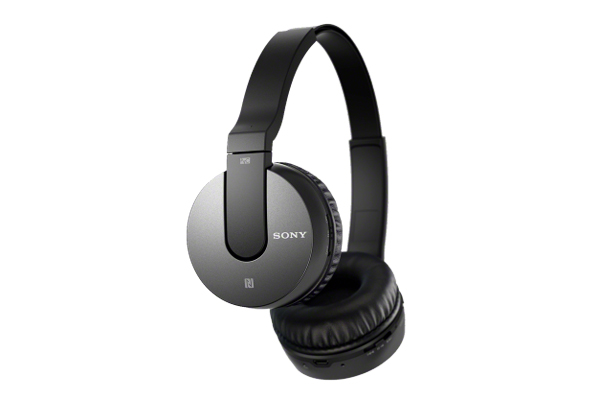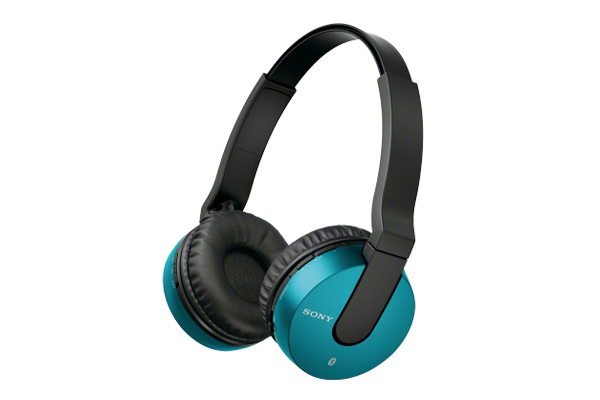Tom's Guide Verdict
The Sony MDRZX550BN headphones offer solid audio quality, a comfortable fit and 16 hours of battery life at a wallet-friendly price.
Pros
- +
Lightweight, comfortable design
- +
Good ambient noise-cancelling technology
- +
Solid battery life
- +
Affordable.
Cons
- -
Audio loses detail when ANC is enabled
- -
No wired option in case the battery dies.
Why you can trust Tom's Guide

When Sony says "no wires," it means no wires. The company's MDRZX550BN headphones ($114) are completely wireless, meaning there's no audio cable to be found. Definitive design choices aside, the on-ear cans offer good sound quality with relatively quiet ambient noise-cancelling technology and 16 hours of battery life. They're not flashy, but they get the job done for a price even the most frugal shoppers can support.
Design
With its palette of black and gray plastic, the MDRZX550BN (we'll call them "the MDR" for short from this point forward) won't stand out in a crowded headphone market. The headband and its corresponding sliders are made from a sturdy yet unremarkable black, matte plastic. The gray, semi-glossy plastic ear caps, which are lined with supple faux leather and resemble a pair of mini doughnuts, are only slightly more interesting.
Overall, the look is stately and clean, but ultimately uninteresting. I would have been happier if Sony had sent over the vivid-blue version, but reviewers can't be choosers, it seems.

Because these are wireless headphones, Sony has strategically placed buttons, ports and sliders around the circumference of the ear caps. For example, you'll find the micro-USB port at the bottom of the right ear cap, with a multifunction slider that features controls for play/pause and skipping tracks forward and backward. The power and volume buttons wrap around the side of the cap, with another button for answering calls stashed away at the top.
The left ear cap is pretty bare by comparison, as it has only an ambient noise cancelling (ANC) control and an embedded NFC chip. I was a bit surprised to discover that the cans are completely wireless, meaning there's no port for an audio cable.
Both ear cups have a rotating pivot that lets you lay them flat for easy storage and portability.
Comfort
The MDR are superlight, thanks to all that plastic; they weigh in at a dainty 5.9 ounces. At 7.9 ounces, the Polk Audio Hinge Wireless headphones aren't much heavier, but there's a noticeable difference in heft between the two.
Get instant access to breaking news, the hottest reviews, great deals and helpful tips.
MORE: Best Headphones
The other standout distinction is the comfort level. The MDR's doughnut-shaped cups, filled with cushy memory foam, pressed firmly against my ears. The pressure was evenly distributed across my freakishly tiny ears, allowing me to rock the cans for close to 2 hours without any complaints. I wish I could have said the same for the Hinge Wireless, which pinched the top of my ears while simultaneously feeling slightly loose on the bottom.
My only real complaint about the MDR is that my ears became sweaty after about 15 minutes of wearing them outdoors. However, this is a problem most on- and over-ear headphones face in the summer months.
Buttons
The MDR serve up a plethora of buttons and sliders for you to play with. There's a small learning curve when you first begin manipulating them and memorizing button placement. However, I was switching tracks, answering calls and adjusting volume like a pro after an hour. Best of all, the controls are compatible with Android, iOS and Windows Phone.
I preferred this setup to the clunky Hinge Wireless' button-dial combo. I ran into difficulty pairing Polk's headphones, because the controls would misinterpret my attempts to connect the cans to my phone. In several instances, the Hinge headphones shut off, even after I held the button for the instructed 3 to 4 seconds to initiate pairing.
I appreciate Polk Audio's attempt to streamline the ways you interact with your headphones. However, in this case, less isn't more — or better.
Ambient noise cancelling
The MDR's ambient noise cancelling is effective in shutting out most ambient noise in a relatively quiet fashion. Once I flipped the switch, otherwise boisterous office chatter was muted to a tolerable whisper.
During a long train ride home from the Jersey shore, the headphones saved me from a loud, inappropriate drunken conversation. The rowdy chat was muffled quicker than you could say, "Get a room, you two."
Unlike most ANC headphones, the MDR are surprisingly quiet. I didn't hear any of the white noise that the competition uses to help keep out unwanted sounds. It also lacked the sometimes unsettling vacuumlike quiet found on the Bose QuietComfort 25 headphones. It's a nice middle ground between the quietly noisy and the deathly quiet.
Performance
When you pay $114 for a pair of headphones, you can expect one or two compromises. In the case of the MDR, you're losing detail in favor of fullness and quiet when the ANC is enabled. However, the cans and their 30-mm drivers still manage to produce a pleasant listening experience most of the time.
I began my tests with Guns N' Roses' "November Rain." With the ANC turned off, I enjoyed the airy soundstage that allowed me to separate the lilting strings and piano cords from the crisp snap of the snare drums. When I flipped the switch to turn on the ANC, I noticed that some of the grit in Axl Rose's vocal was gone, as well as some of the warmth. The Polk Audio Hinge Wireless' enhanced bass injected unnecessary lows that made the entire track sound like it was recorded underwater.
As I listened to Usher's "Here I Stand," my ears were assaulted by a harsh keyboard and electronic wind instrument (EWI). The heavy reverb was even worse, as it dirtied up the track and took away from the singer's usually warm tenor. The problem areas were less intense when ANC was engaged. Thanks to its bassy audio signature, the Hinge Wireless weren't much better. Not only were the EWI and keyboards grating, but the vocals were slightly submerged thanks to the artificial lows.
Bluetooth/NFC
The MDR connect to your devices via Bluetooth 3.0 and NFC. Neither method is particularly difficult — all you need to do to pair them via NFC is quickly touch the headphones with the intended NFC-enabled device. The alternative method requires you to hold down the power button for 7 seconds.
MORE: Best Bluetooth Speakers
Battery Life
Sony claims the MDR will deliver 17 hours of battery life with the ANC activated and 21 hours with the feature disabled. I got approximately 16 hours with the ANC enabled after using the headphones for 2 hours a day. It's definitely better than what we saw from the Polk Audio Hinge Wireless headphones, but not even close to the Plantronics BackBeat Pro's astonishing 60 hours.
Because the MDR are completely wireless, however, you'll definitely want to be sure you top the battery off every now and then. Otherwise, you might find yourself stranded in a loud subway car with no way to protect your delicate ears.
Call Quality
I was impressed with the MDR's audio quality during phone calls. When I called my mother, her voice was loud and crystal clear, with details so sharp I could hear her car's air conditioning. She knew immediately that I was using a pair of headphones but still reported relatively clear sound, even though I was calling her from a busy New York City street.
Bottom Line
It's not the prettiest pair of headphones, but the Sony MDRZX550BN get the job done. The cans offer solid audio quality, a comfortable fit, 16 hours of battery life and great active noise cancelling. The audio does take a slight hit when the ANC is engaged, but most mainstream listeners won't really notice.
However, those who prefer a little more boom should check out the Polk Audio Hinge Wireless headphones. At $199, they're more expensive, but they offer fuller sound, particularly on the lows. Overall, though, for $114, the MDR are a great choice for value-minded shoppers looking for a pair of good-sounding wireless headphones with long battery life.
Sherri L. Smith is a Senior Writer at Tom's Guide. When she's not reviewing the latest headphones and speakers, you'll find her gaming on her Xbox One, PlayStation 4 or PC. Follow Sherri at @misssmith11. Follow us @TomsGuide and on Facebook.

Sherri L. Smith has been cranking out product reviews for Laptopmag.com since 2011. In that time, she's reviewed more than her share of laptops, tablets, smartphones and everything in between. The resident gamer and audio junkie, Sherri was previously a managing editor for Black Web 2.0 and contributed to BET.Com and Popgadget.

